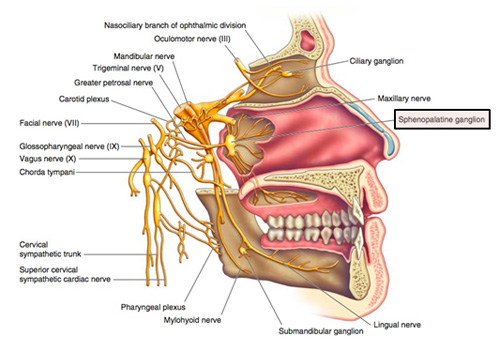SPHENOPALATINE BLOCKS, RFA & NEUROLYSIS
Indications
Diagnose the cause of pain in the face and head
Manage the pain of certain types of chronic headaches
Manage sympathetically maintained facial pain
Procedure
The sphenopalatine ganglion (SPG) is a collection of nerves (sympathetic, parasympathetic and some sensory). It lies in a body cavity called the pterygopalatine fossa, which is deep in the midface.
It supplies the lachrymal gland, paranasal sinuses, glands of the mucosa of the nasal cavity and pharynx, the gingival, and the mucous membrane and glands of the hard palate. It is not involved in feeling or movement.
Sometimes after a nerve is sensitized by trauma, infection or other causes, the sympathetic activity can cause pain. Blocking the sympathetic activity by anesthetizing the SPG may stop the pain. During a sphenopalatine ganglion block, pain-relieving medicine is injected to the region where the ganglion lies under fluoroscopic guidance. This may reduce the release of the chemical norepinepherine activating the pain sensitive nerves and reduce the pain.
The patient is usually sedated, and using X-ray (fluoroscopy) guidance, a fine needle is placed near the SPG and anesthetic is injected. The patient will not feel numbness in the face. Pain relief may also not be immediate. If pain relief is good with local anesthetic but for a few days or weeks we do a radiofrequency ablation of SPG or neurolysis for long lasting pain relief.

Special Instructions
Side Effects And Complications
- Mild swelling of the face is common so Ice fomentation is needed.
- No other complication occurs in expert hands.
Procedures
- EPIDURAL STEROID BLOCK ( TFESI, CAUDAL, INTERLAMINAR )
- CERVICAL EPIDURAL NEUROPLASTY
- INTRAARTICULAR FACET BLOCKS
- MEDIAL BRANCH RFA FOR FACETOGENIC PAIN
- THIRD OCCIPITAL NERVE BLOCKS AND RFA
- C0-C1 and C1-C2 BLOCKS
- OCCIPITAL NERVE BLOCKS AND RFA
- SACROILIAC JOINT BLOCKS and RFA
- GASSERIAN RFA FOR TRIGEMINAL NEURALGIA
- BALLOON COMPRESSION FOR TRIGEMINAL NEURALGIA
- INTRAARTICULAR SHOULDER PROCEDURES
- PROLOTHERAPY
- PRP THERAPY
- GENICULAR NERVE RFA FOR KNEE PAIN
- LUMBAR SYMPATHECTOMY FOR LOWER LIMB ISCHEMIA & CRPS
- T2-T3 GANGLION NEUROLYSIS FOR UPPER LIMB ISCHEMIA AND CRPS
- STELLATE GANGLION BLOCKS AND RFA
- TRIGGER POINT INJECTIONS
- INTRARTICULAR TMJ PROLOTHERAPY
- KNEE JOINT INJECTIONS INCLUDING VISCOSUPPLEMENTATION
- CELIAC PLEXUS BLOCKS AND NEUROLYSIS
- SUPERIOR HYPOGASTRIC PLEXUS BLOCKS AND NEUROLYSIS
- GANGLION IMPAR BLOCK AND RFA